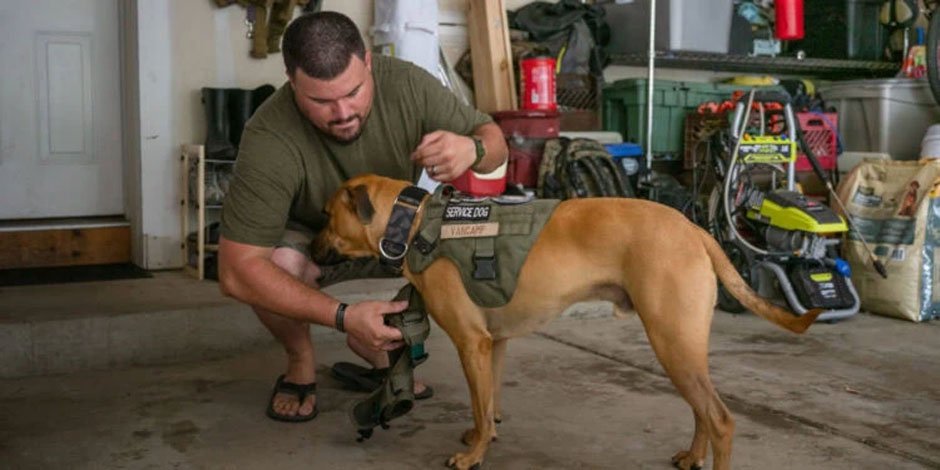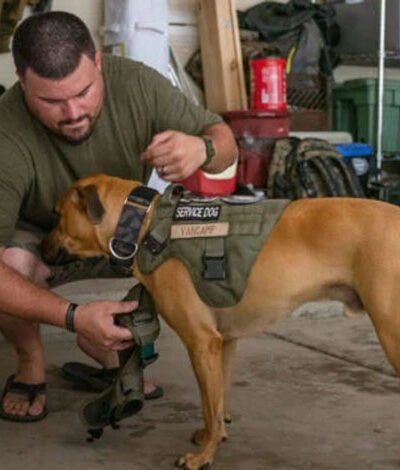 When we talk about the mental health challenges veterans face, PTSD often takes center stage. But for many, the emotional weight of military life doesn’t end there. Veterans navigating life after service frequently deal with anxiety, depression, grief, disconnection, and loss of structure.
When we talk about the mental health challenges veterans face, PTSD often takes center stage. But for many, the emotional weight of military life doesn’t end there. Veterans navigating life after service frequently deal with anxiety, depression, grief, disconnection, and loss of structure.
Emotional support animals (ESAs) offer a powerful, grounded way to manage those challenges. These loyal companions provide more than comfort. They help rebuild daily routines, emotional safety, and a sense of purpose.
In this article, we’ll explore how ESAs support veterans beyond trauma recovery and offer practical next steps for those considering an ESA for PTSD.
The Emotional Landscape of Civilian Life for Veterans
The transition from military service to civilian life can feel like crossing a wide emotional chasm. Veterans often go from tightly bonded units and structured schedules to isolation, identity shifts, and a lack of clear direction.
Common emotional challenges include:
- Depression or emotional flatness – A feeling of numbness or lack of motivation
- Anxiety or hyper-awareness – Struggling to relax or feeling constantly on edge
- Loss of purpose – Missing the sense of mission and structure from military life
- Difficulty connecting with others – Feeling misunderstood or disconnected from civilians
These emotional shifts don’t always meet the criteria for PTSD but can still deeply affect day-to-day life. That’s where emotional support animals come in.
What Is an Emotional Support Animal?
An emotional support animal is any domesticated animal that provides comfort and companionship to a person experiencing emotional or mental health challenges.
Unlike service animals, ESAs are not trained to perform tasks. Instead, their therapeutic benefit lies in their presence. They reduce feelings of isolation, help regulate emotions, and offer a reliable source of connection and calm.
To be legally recognized, an ESA must be prescribed by a licensed mental health professional (LMHP) through an ESA letter. This allows the individual to live with their animal in housing that would otherwise restrict pets.
Ways ESAs Support Veterans Beyond PTSD
Emotional support animals help veterans in many subtle but powerful ways. Beyond treating trauma, they offer steady companionship and daily structure that supports long-term mental health.
Combating Loneliness and Disconnection
After leaving the military, many veterans find it difficult to form deep connections again. ESAs fill part of that emotional gap.
Their constant companionship provides daily emotional support that can ease feelings of detachment. Even simple actions, such as a dog resting its head on your lap or a cat curling up beside you, can help veterans feel less alone.
Reintroducing Routine and Responsibility
Military life runs on structure. When that disappears, it’s easy to feel unmoored.
ESAs create a new kind of structure that brings a sense of control and rhythm to daily life through:
- Feeding times
- Walks
- Grooming
- Play
For many veterans, this kind of responsibility feels empowering rather than burdensome.
Easing Anxiety and Restlessness
Hyper-awareness, racing thoughts, or difficulty settling down are common post-service experiences. Animals naturally help downregulate the nervous system.
Petting a dog, listening to a cat purr, or simply sharing space with an animal has been shown to reduce cortisol levels and encourage emotional grounding.
Helping With Depression and Emotional Numbness
Depression can make it hard to get out of bed, leave the house, or even care about the day. But animals have a way of inviting you back into life, without judgment or pressure.
The connection with an ESA can help break emotional flatness by encouraging gentle movement, engagement, and emotional expression. A walk around the block with your dog or brushing your pet can feel like a meaningful accomplishment.
Supporting Substance Recovery or Grief
For veterans navigating addiction recovery or the loss of comrades, consistency and emotional grounding are essential. ESAs provide both.
Their steady presence can offer nonverbal comfort during moments of grief or emotional turbulence, acting as a buffer against triggers or relapse risk.
Real-Life Impact: What Veterans Say About Their ESAs
Veterans across the country have shared heartfelt stories about how their ESAs have provided comfort, purpose, and a renewed sense of well-being.
These veteran testimonials showcase some of these profound impacts:
- “With Radar by my side, I can continue working and have an overall sense of well-being.” – Sharon & Radar
- “Bailey is not my dog. I am Honored and privileged to be his Marine.” – Jack & Bailey
- “[Bradley] has a bond with me that a person nor a material item can provide.” – Mark & Bradley
ESAs don’t replace therapy or medication when needed, but they do enhance the emotional fabric of a veteran’s life.
How to Know If an ESA Might Help You
You don’t need a specific diagnosis to wonder if an ESA could support your mental health.
Consider whether any of the following apply:
- You feel more emotionally stable or calm around animals
- You’re experiencing anxiety, loneliness, or low mood
- You want support that feels personal and non-clinical
- You’re capable of caring for a pet and want to deepen that bond
If you nodded yes to a few of those, it may be time to explore getting an ESA letter.
How Veterans Can Get an ESA Letter
Getting a legitimate ESA letter is a simple but meaningful process:
- Schedule a consultation with a licensed mental health provider
- Discuss your symptoms, challenges, and what kind of support you’re looking for
- If appropriate, the provider will issue a formal ESA letter that includes their license number, signature, and your qualifying condition
No special training, registration, or ID card is required—just the letter.
Veterans in California and other states can also learn more about ESA qualifications and housing rights through Pettable’s ESA for veterans resource hub.
Final Thoughts: Quiet Support That Matters
Emotional healing after military service isn’t always loud or linear. Sometimes, it’s a quiet walk with a dog. A soft nudge from a cat during a hard day.
You don’t need to wait for a PTSD diagnosis to seek support. If you’re a veteran navigating emotional challenges, a carefully chosen emotional support animal could offer the stability, care, and love you deserve.
When you’re ready to take the next step, Pettable can help you determine if you qualify and guide you through the ESA letter process.
FAQs
Q: Can veterans get an ESA without having PTSD?
Yes. Anxiety, depression, or emotional distress are valid reasons for ESA support.
Q: Are ESAs the same as service dogs for veterans?
No. ESAs offer comfort through companionship but aren’t trained for specific tasks.
Q: Can I bring my ESA to the VA or on base?
No. ESA rights are limited to housing under the Fair Housing Act.
Q: Will my landlord accept my ESA if it’s a restricted breed?
Yes. Landlords must waive breed restrictions for valid ESA letters.
Q: What animals can be ESAs for veterans?
Most commonly dogs and cats, but any domesticated animal that provides emotional comfort may qualify.





Leave a Reply